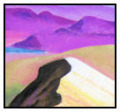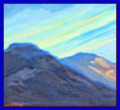GALLERIES
The work in these galleries reflects my main interest both in painting per se and in the landscape sensu lato in particular. The paintings constitute several series of works each exploring a common theme, such as "landscapes of marginality" exemplified here. The paintings are both figurative and semi abstract, and the theme underpinning each series has some personal meaning and emotional motivation for me. In the works I have sought to explore what I have referred to as the ..
THE LANDSCAPE PAINTER'S CHALLENGE:
The motif of a landscape painting is the content of the scene, the character of a portion of three dimensional space constrained within the two dimensions of the picture plane. This is both the "what" of the painting and the "where and when" constrained in space and time.
However, real places are more than space perceived by our senses. They are complex entities, each an amalgam of actual and imagined space and as such they possess emotional properties, an essence or spirit of place. Landscapes are a complex of such places and their connectivity, their connectedness in space and time. They are spatial constructs and have been described variously as palimpsests of history or as texts that need to be read. So, in the first case they capture a fragmentary narrative of change over time, and in the second if those fragments are read correctly they tell a story revealing an explanation of how and why the landscape came to be as it is.
In other words to understand and to convey the inherent complexity of any landscape requires the artist to engage not only with what is there, where it is and when we are viewing it, but also to address how it came to be as it is and why this should have been so. At the same time the artist needs to transcend these objectives and attempt to capture the emergent spiritual properties resonant in the landscape.
Of course, this presents a formidable challenge to the artist and not every work will or indeed can be as comprehensive in its engagement with its subject as the argument here might suggest.
*
THE LANDSCAPE PAINTER'S CHALLENGE:
The motif of a landscape painting is the content of the scene, the character of a portion of three dimensional space constrained within the two dimensions of the picture plane. This is both the "what" of the painting and the "where and when" constrained in space and time.
However, real places are more than space perceived by our senses. They are complex entities, each an amalgam of actual and imagined space and as such they possess emotional properties, an essence or spirit of place. Landscapes are a complex of such places and their connectivity, their connectedness in space and time. They are spatial constructs and have been described variously as palimpsests of history or as texts that need to be read. So, in the first case they capture a fragmentary narrative of change over time, and in the second if those fragments are read correctly they tell a story revealing an explanation of how and why the landscape came to be as it is.
In other words to understand and to convey the inherent complexity of any landscape requires the artist to engage not only with what is there, where it is and when we are viewing it, but also to address how it came to be as it is and why this should have been so. At the same time the artist needs to transcend these objectives and attempt to capture the emergent spiritual properties resonant in the landscape.
Of course, this presents a formidable challenge to the artist and not every work will or indeed can be as comprehensive in its engagement with its subject as the argument here might suggest.
*




